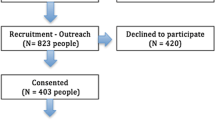Abstract
Previous research has shown that multi-unit housing (MUH) residents are at risk of secondhand smoke (SHS) exposure, which can transfer between units. The purpose of this study was to determine SHS exposure and examine attitudes towards smoking policies among public housing authority (PHA) residents in rural and tribal settings. A self-administered questionnaire was completed by 895 adult tenants (41 % response rate) living in PHA multiunit buildings in Montana in 2013. Our primary outcome was tenant support of smoke-free policies; our secondary outcome was exacerbation of child asthma symptoms due to SHS exposure. In 2014, we used multiple logistic regression models to test associations between independent variables and outcomes of interest. The majority (80.6 %) of respondents supported having a smoke-free policy in their building, with support being significantly higher among nonsmokers [adjusted odds ratio (aOR) 4.2, 95 % confidence interval (CI) 1.5–11.6] and among residents living with children (aOR 2.9, 95 % CI 1.3–6.2). Tribal residents were as likely to support smoke-free policies as non-tribal residents (aOR 1.4; 95 % CI 0.5–4.0). Over half (56.5 %) of respondents reported SHS exposure in their home; residents in a building with no smoke-free policy in place were significantly more likely to report exposure (aOR 3.5, 95 % CI 2.2–5.5). SHS exposure was not significantly associated with asthma symptoms. There is a significant reduction in exposure to SHS in facilities with smoke-free policies and there is strong support for such policies by both tribal and non-tribal MUH residents. Opportunities exist for smoke-free policy initiatives in rural and tribal settings.
Similar content being viewed by others
References
Health consequences of involuntary exposure to tobacco smoke: A report of the Surgeon General. (2006). Retrieved from Atlanta, GA: http://www.surgeongeneral.gov/library/reports/secondhandsmoke/executivesummary.pdf.
Kaufmann, R., Babb, S., O’Halloran, A., et al. (2010). Vital signs: Nonsmokers’ exposure to secondhand smoke—United States, 1999–2008. Retrieved from Atlanta, GA: http://www.cdc.gov/mmwr/preview/mmwrhtml/mm5935a4.htm?s_cid=mm5935a4_w.
King, B., Babb, S., Tynan, M., & Gerzoff, R. (2013). National and state estimates of secondhand smoke infiltration among U.S. multiunit housing residents. Nicotine and Tobacco Research, 15(7), 1316–1321. doi: http://ntr.oxfordjournals.org/content/15/7/1316.
King, B., Dube, S., & Homa, D. (2013). Smoke-free rules and secondhand smoke exposure in homes and vehicles among US adults, 2009–2010. Preventing Chronic Disease. doi:10.5888/pcd10.120218.
Montana Department of Public Health and Human Services. (2013). Montana Adult Tobacco Survey.
Winickoff, J., Gottlieb, M., & Mello, M. (2010). Regulation of smoking in public housing. New England Journal of Medicine, 362(23), 2319–2325. doi: http://www.nejm.org/doi/full/10.1056/NEJMhle1000941.
Hewett, M., Sandell, S., Anderson, J., & Niebuhr, M. (2007). Secondhand smoke in apartment buildings: Renter and owner or manager perspectives. Nicotine and Tobacco Research, 9(Suppl. 1), S39–S47. doi: http://ntr.oxfordjournals.org/content/12/11/1133.
King, B., Travers, M., Cummings, K., Mahoney, M., & Hyland, A. (2010). Prevalence and predictors of smoke-free policy implementation and support among owners and managers of multiunit housing. Nicotine and Tobacco Research, 12(2), 159–163. doi: http://ntr.oxfordjournals.org/content/12/6/598.
Ballor, D., Henson, H., & BacGuire, K. (2013). Support for no-smoking policies among residents of public multiunit housing differs by smoking status. Journal of Community Health, 38(6), 1074–1080. doi: http://link.springer.com/article/10.1007/s10900-013-9716-7/fulltext.html.
Drach, L., Pizacant, B., Rohde, K., & Schubert, S. (2010). The acceptability of comprehensive smoke-free policies to low-income tenants in subsidized housing. Preventing Chronic Disease, 7(3), A66. doi: http://www.cdc.gov/pcd/issues/2010/May/09_0209.htm.
Hood, N., Ferketich, A., Klein, E., Wewers, M., & Pirie, P. (2013). Individual, social, and environmental factors associated with support for smoke-free housing policies among subsidized multiunit housing tenants. Nicotine and Tobacco Research, 15(6), 1075–1083. doi: http://ntr.oxfordjournals.org/content/15/6/1075.
Pizacani, B., Maher, J., Rohde, K., Drach, L., & Stark, M. (2012). Implementation of a smoke-free policy in subsidized multiunit housing: Effects on smoking cessation and secondhand smoke exposure. Nicotine and Tobacco Research, 14(9), 1027–1034. doi: http://ntr.oxfordjournals.org/content/early/2012/02/27/ntr.ntr334.abstract.
Biazzo, L. (2008). Breathing easier in big sky country: Montanans support the Montana clean indoor air act. Montana Public Health: Prevention Opportunities Under the Big Sky, 3(12). doi: http://dphhs.mt.gov/publichealth/Montana-Public-Health#313283999-2008-issues.
Montana Clean Indoor Air Act, Montana Code Annotated 50 § 1 (2005).
Licht, A., King, B., Travers, M., Rivard, C., & Hyland, A. (2012). Attitudes, experiences, and acceptance of smoke-free policies among U.S. multiunit housing residents. American Journal of Public Health, 102(10), 1868–1871. doi: http://ajph.aphapublications.org/doi/abs/10.2105/AJPH.2012.300717.
Burdette, L., Rowe, G., Johansen, L., Kerkvliet, J., Nagelhout, E., & Lewis, K. (2014). A statewide assessment of smoke-free policy in multiunit housing settings. Nicotine & Tobacco Research, 16(12), 1593–1598.
Arheart, K., Lee, D., Fleming, L., LeBlanc, W., & Dietz, N. (2008). Accuracy of self-reported smoking an secondhand smoke exposure in the US workforce: the National Health and Nutrition Examination Surveys. Journal of Occupational and Environmental Medicine, 50(12), 1414–1420. doi:10.1097/JOM.0b013e318188b90a.
Hennrikus, D., Pentel, P., & Sandell, S. (2003). Preferences and practices among renters regarding smoking restrictions in apartment buildings. Tobacco Control, 12, 189–194. doi:10.1136/tc.12.2.189.
Acknowledgments
The authors would like to thank the faculty mentors from ICF International, and specifically George Rutherford, MD, for editorial assistance and consultation. This paper was supported in part by a cooperative agreement with the Centers for Disease Control and Prevention (Grant No. 2U58DP00197706). The findings and conclusions in this paper are those of the authors and do not necessarily represent the official position of the Centers for Disease Control and Prevention (CDC). CDC supported staff training and technical assistance to aid in the development of this manuscript through a contract with ICF International (Contract No. 200-2011-F-42029).
Author information
Authors and Affiliations
Corresponding author
Ethics declarations
Conflicts of interest
The authors declare that they have no conflicts of interest.
Rights and permissions
About this article
Cite this article
Schmidt, L.M., Reidmohr, A.A., Helgerson, S.D. et al. Secondhand Smoke Exposure and Smoke-Free Policy Support Among Public Housing Authority Residents in Rural and Tribal Settings. J Community Health 41, 1116–1121 (2016). https://doi.org/10.1007/s10900-016-0204-8
Published:
Issue Date:
DOI: https://doi.org/10.1007/s10900-016-0204-8



